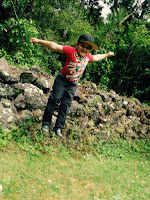We also know, as do all our whānau, that our children are confident, capable and willing (as well as wanting and needing) to push their boundaries; to engage in some risky activities which ultimately will provide opportunities for them to learn new skills, try new behaviours and reach their fullest potential.
This week I read an interesting article about risky play by Peter Gray - a researcher in educational psychology from Boston University - and it made me think really hard about our play at Mairtown and what we consider is normal and expected for children’s learning and development.
So just briefly I thought I’d share some photos of our children engaged in play that feels risky for them, along with a couple of extracts from the article. I hope it makes you think as much as it did me – risky play can be worrisome to observe as an adult - yet I know I climbed trees, tried to jump across streams etc., as a child - at the time, that was what I sought out and craved. I feel that risky play is something that children need and ultimately have a right to experience. How does it make you feel?
Children are designed by nature to teach themselves emotional resilience by playing in risky, emotion-inducing ways. In the long run, we endanger them far more by preventing such play than by allowing it. And, we deprive them of fun (Peter Gray, 2014)
Children are highly motivated to play in risky ways, but they are also very good at knowing their own capacities and avoiding risks they are not ready to take, either physically or emotionally. Our children know far better than we do what they are ready for…Children know how to dose themselves with just the right amount of fear, for them, and for that knowledge to operate they must be in charge of their own play. (Peter Gray, 2014).
In risky play, youngsters dose themselves with manageable quantities of fear and practice keeping their heads and behaving adaptively while experiencing that fear. They learn that they can manage their fear, overcome it, and come out alive. In rough and tumble play they may also experience anger, as one player may accidentally hurt another. But to continue playing, to continue the fun, they must overcome that anger. If they lash out, the play is over. Thus…[risky] play is, among other things, the way that young [children] learn to control their fear and anger so they can encounter real-life dangers, and interact in close quarters with others, without succumbing to negative emotions (Peter Gray, 2014)
Ma te wa, Christine














1 comment:
In our fearful society, whether it be that a child gets injured or a lawsuit filed, we have taken away so much learning through play. Students at many schools are no longer permitted to play Tag and Red Rover. Swings and slides are being removed as school districts have been sued. I've often remarked that playgrounds will soon be called "stands" because that will be all the children will be permitted to do, at the rate things are going! I applaud the "risky play" notion, yes children will fall down but with guidance and childs own concept as to what they feel they are capable of, injuries will be slight, in my opinion. Confidence will be gained in the process which will only spread over to academics! How exciting!
Post a Comment